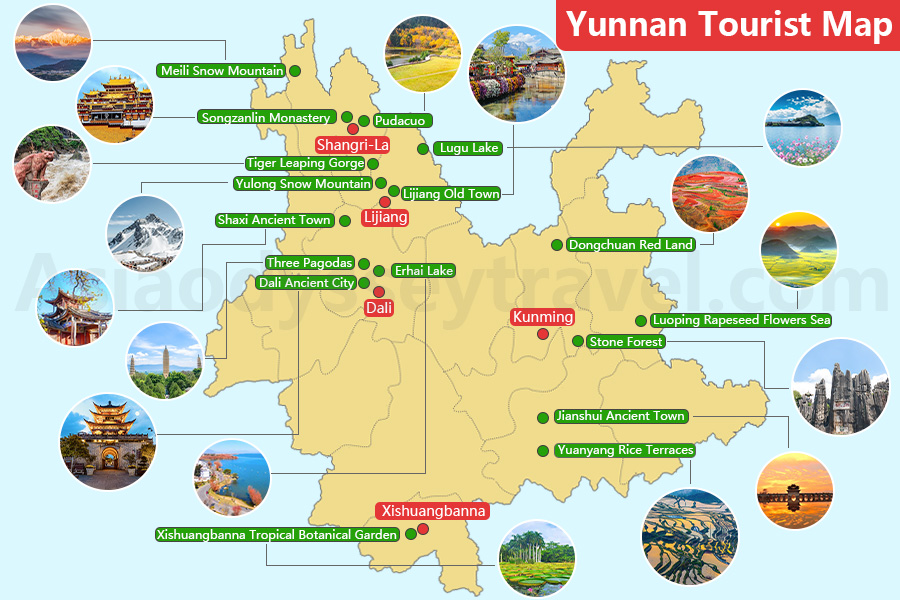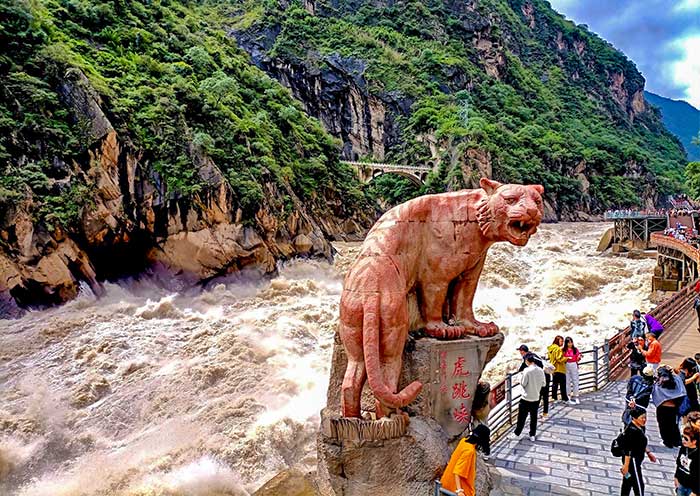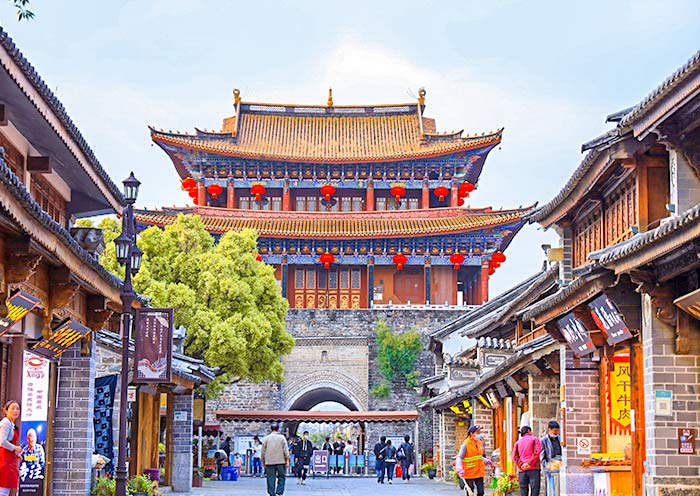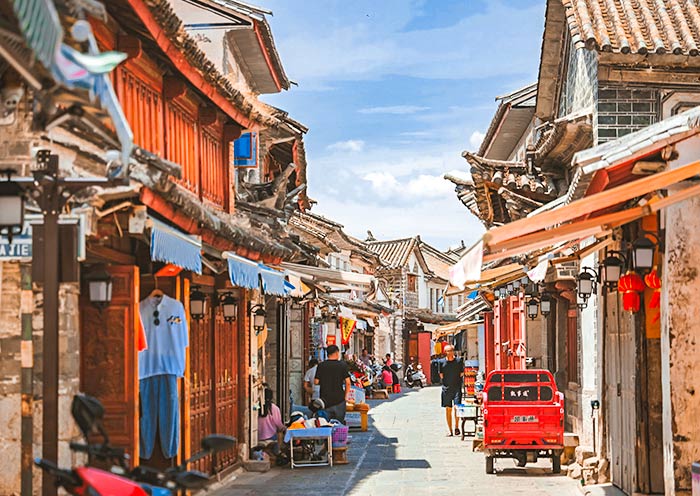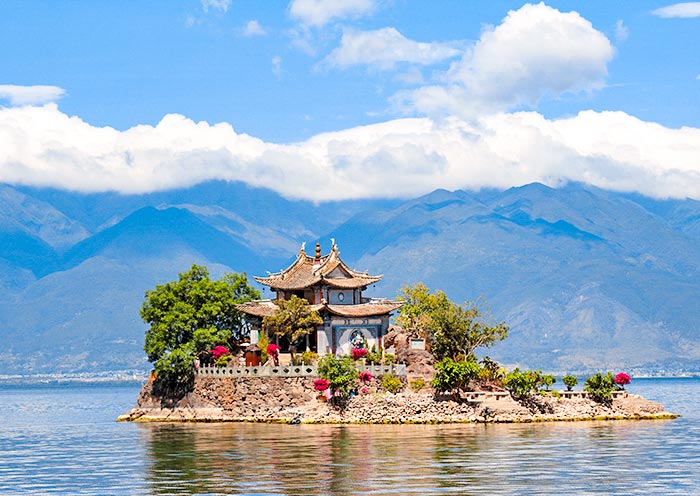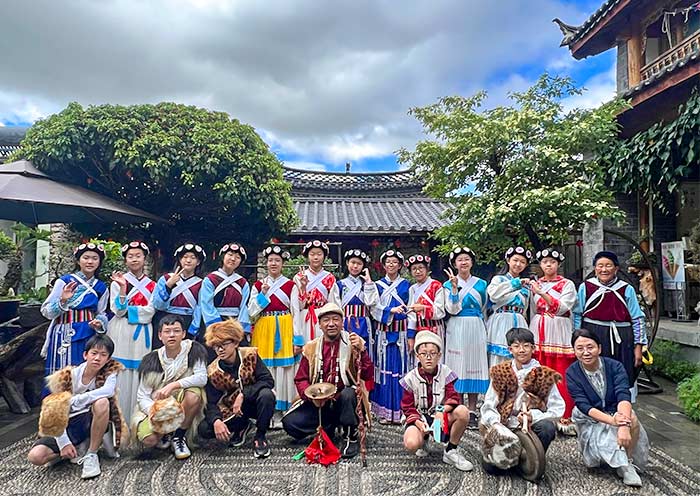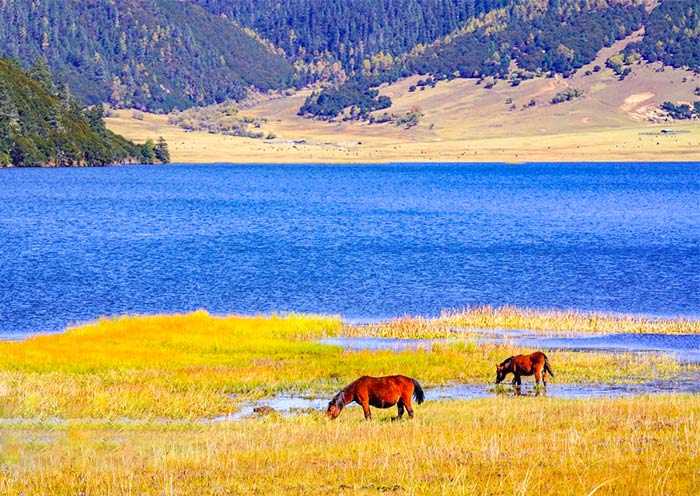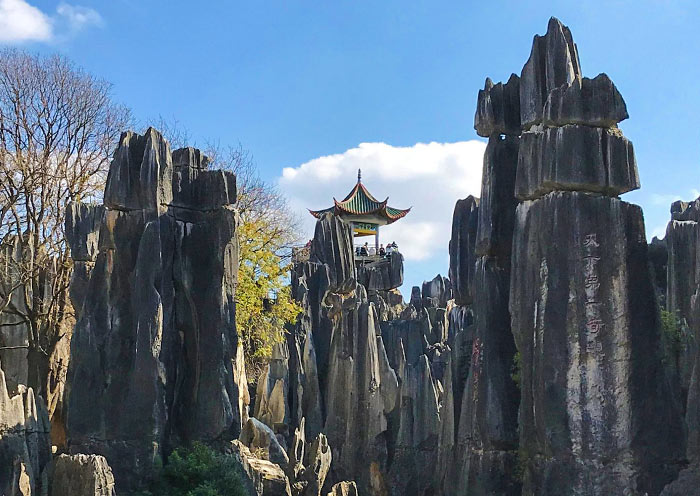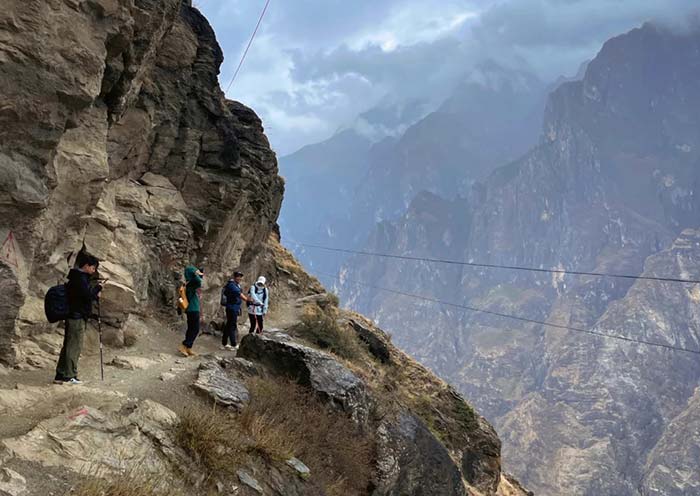What is Lijiang Old Town?
Also known as Dayan Old Town, this place has been around for more than 800 years. Back in the day, it was a key stop on the Ancient Tea Horse Road—a trade route where tea from Yunnan was swapped for Tibetan horses.
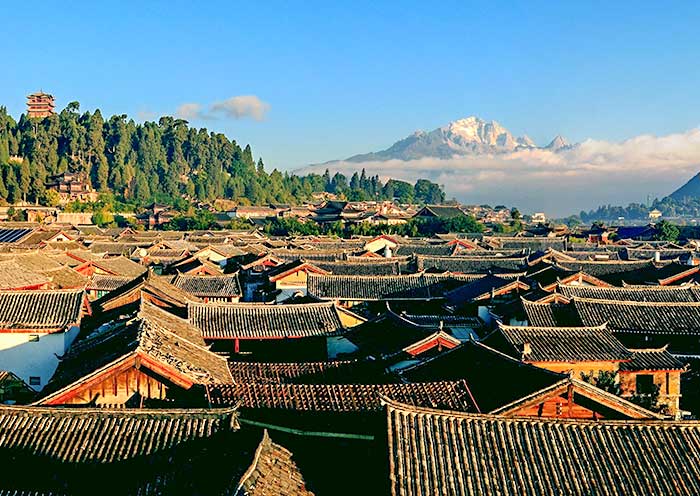
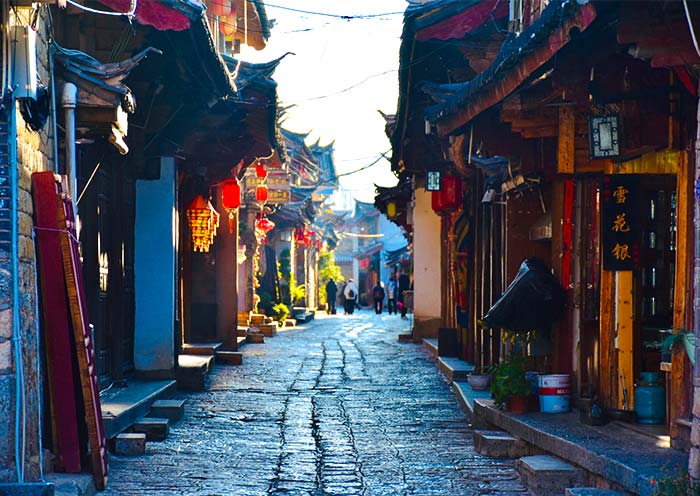
That mix of travelers and cultures left its mark, giving Lijiang its one-of-a-kind charm. In 1997, UNESCO named it a World Heritage Site, which basically means it's officially recognized as a treasure worth protecting. And when you wander through its streets, you'll quickly see why.
Here's what makes it unmissable:
Living Culture: This is the heartland of the Naxi ethnic minority, who carry on their traditions with pride. You'll spot the world's only surviving pictographic writing system—the Dongba script—on shop signs, cultural exhibits, and even souvenirs.
Unique Architecture: Wooden houses, stone-paved lanes, and delicate bridges—all blending Naxi, Han, and Tibetan styles into something you won't find anywhere else.
Stunning Scenery: Where else can you sip tea by a canal and look up to see the towering Jade Dragon Snow Mountain in the distance? The harmony between man-made beauty and natural splendor is unforgettable.
Vibrant Atmosphere: By day, it's a charming maze of courtyards, tea houses, and boutique shops. By night, the town transforms—music drifts from lively bars, lanterns light up every corner, and the old town takes on a festival-like glow.
Lijiang (Dayan) Old Town Map & Layout
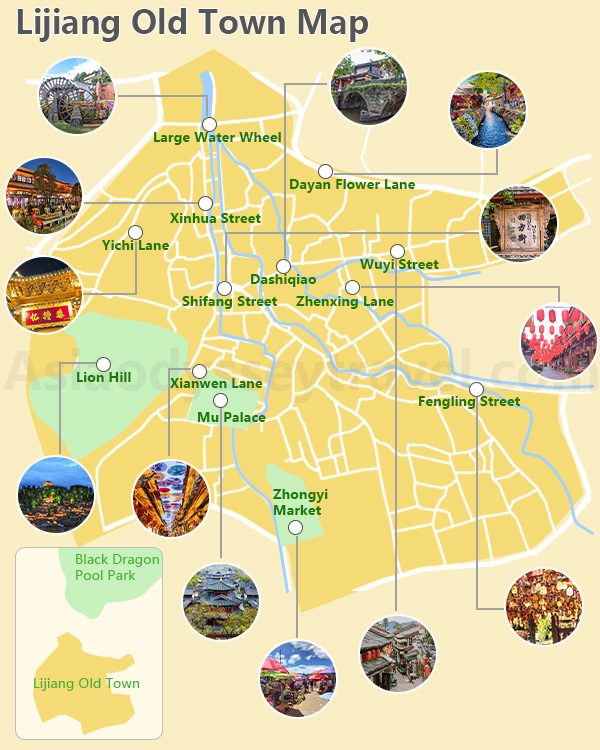
Think of Lijiang Old Town as a big web, with Sifang Street (Square Street) at the center. From here, narrow alleys stretch out like spokes on a wheel, each lined with canals, bridges, and traditional wooden houses.
- South Gate (Entrance & Stay Hub): Many travelers enter from the South Gate, where most hotels and guesthouses cluster. It's a good starting point for exploring.
- Central Core – Sifang Street (四方街): This lively square is the heart of the Old Town, always buzzing with shops, teahouses, and performers. From here, you can easily branch off into smaller alleys.
- North Gate & the Large Water Wheel: The most iconic landmark of the Old Town. It's also the link between the Old Town and Black Dragon Pool Park.
- West Side – Mu Palace & Lion Mountain: The palace grounds and Wangu Tower sit here, perfect for history and panoramic views.
- East & Northeast – Wuyi Street, Xinhua Street, Dayan Flower Lane: A mix of street food, bars, and boutiques. This area comes alive at night.
- Hidden Corners – Fengling Street, Zhenxing Lane, Xianwen Lane: Quieter alleys where you can stumble upon lanterns, wind chimes, or umbrella displays, away from the busiest crowds.
The Old Town isn't a grid — it's a labyrinth designed for wandering. The canals often guide your path, and every alley seems to loop back toward Sifang Street eventually. With your map in hand, you'll have both the landmarks and the little details to make sense of the maze.

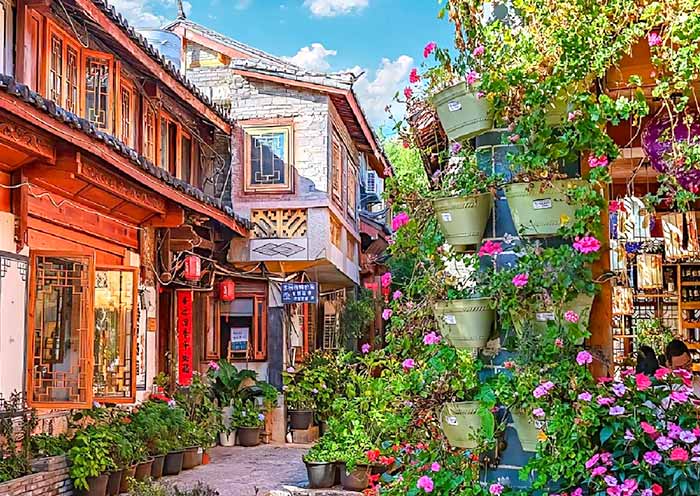
What to See and Do: The Best of Lijiang Old Town
Master the Maze
The number one "activity" in Lijiang Old Town is simple: get lost. Step away from the busy Square Street and let yourself wander into the side alleys, guided only by the sound of canals and the glow of lanterns. But if you want a little direction, here's a cheat sheet of the most atmospheric streets and when to visit them:
By Day – Strolling with Sunshine
- Dayan Flower Lane (大研花巷): A street draped with blossoms, perfect for a lazy coffee or afternoon tea by the water.
- Fengling Street (风铃街): Lined with wind chimes that tinkle in the breeze — the ideal place for a quiet daytime wander.
- Zhenxing Lane (振兴巷): Red lanterns hanging on the eaves give this street a classic Old Town vibe, especially photogenic in the daylight.
- Dashiqiao (大石桥): A romantic stone bridge framed by flowers and canals — bring your camera, it's one of the most iconic backdrops.
By Night – When the Town Comes Alive
- Xinhua Street (新华街): Famous for its nightlife — bars with neon lights, loud music, and dancing crowds.
- Wuyi Street (五一街): A quieter bar street where you can listen to folk singing in small pubs — a nice contrast to Xinhua's party vibe.
- Xianwen Lane (现文巷): The romantic umbrella street, where colorful oiled-paper umbrellas turn the alley into an Instagram dream.
- Yichi Lane (忆持巷): Known for its vibrant ethnic minority performances, adding music, dance, and a festive spirit to your evening stroll.
Tip: Start your day in the peaceful alleys with flowers and wind chimes, then return in the evening for lantern-lit streets, live music, and local snacks. This way, you'll experience both the serenity and the buzz that make Lijiang Old Town unforgettable.
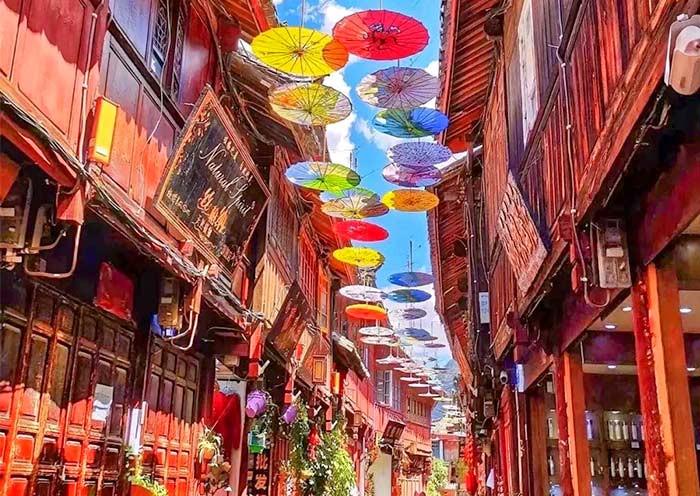
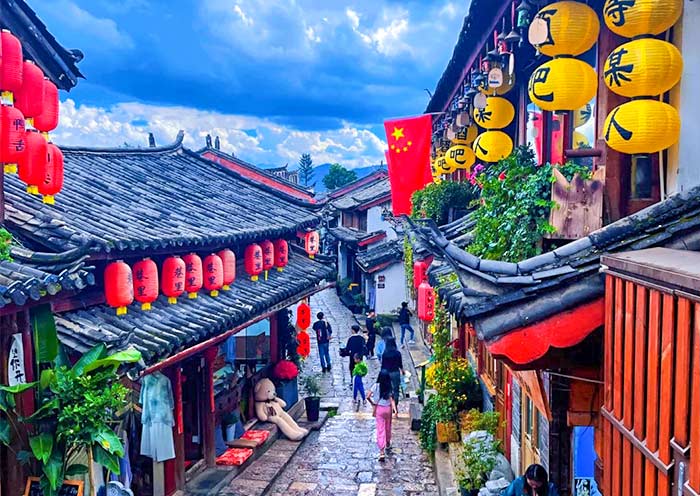
Sifang Street (Square Street)
Think of this as Lijiang's living room. It's the main square where everyone seems to gather—locals chatting, travelers resting, performers adding music to the air. Grab a snack, sit by the canal, and just soak it all in. This is where you really feel the heartbeat of the town.
The Water Wheels & North Gate
If you've seen photos of Lijiang Old Town, chances are you've seen the massive wooden water wheels at the entrance. They're not just decorative—they're an iconic symbol of the town. Standing here at the North Gate, you'll know you've officially arrived in one of China's most famous historic towns.
Mu's Residence (Mufu Palace)
Once the home of the powerful Mu family who ruled Lijiang for centuries, this palace is sometimes called the "Forbidden City of the South." With grand halls, courtyards, and gardens, it gives you a peek into how the town's elite lived back in the Ming and Qing dynasties.

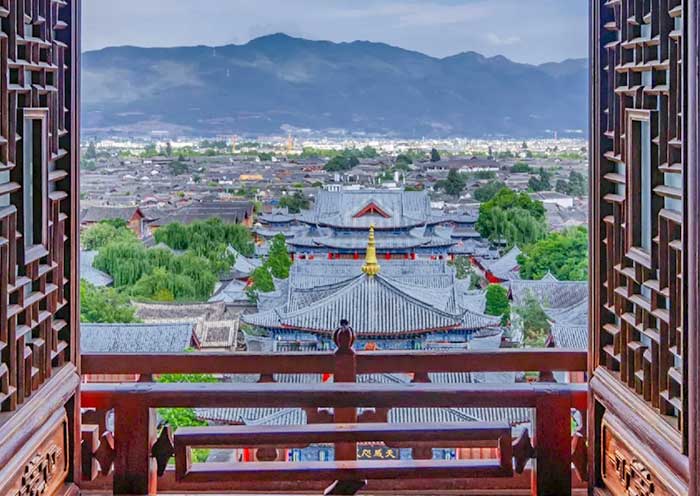
Lion Hill & Wangu Tower
Need that postcard-perfect view? Head up Lion Hill to Wangu Tower, where you'll find a sweeping panorama of tiled rooftops stretching toward the dramatic backdrop of Jade Dragon Snow Mountain. Sunset here is especially magical—the whole Old Town glows.
Black Dragon Pool Park
One of the most photographed spots in all of China, this park gives you that classic shot: Jade Dragon Snow Mountain mirrored in the clear waters of Black Dragon Pool. It's also home to the Dongba Culture Museum, where you can learn about the Naxi people's traditions and unique writing system.
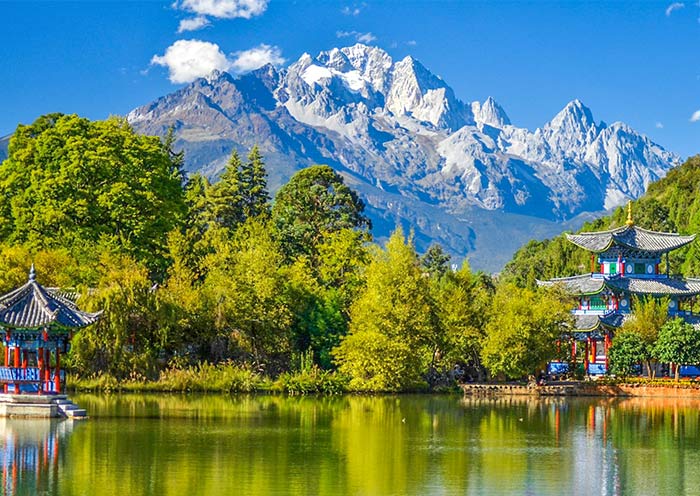

Experiencing the Naxi Culture
Naxi Ancient Music:
Step into another era with a performance of Naxi Ancient Music, one of the world's oldest surviving music traditions. The instruments and melodies feel timeless, and the performances are usually held in cozy old-town theaters that make the experience even more atmospheric.
Local Life & Handicrafts:
Part of Lijiang's charm lies in its hidden corners. Wander off the main streets and you'll find artisans crafting silver jewelry, handwoven textiles, and traditional Naxi clothing. Don't rush—half the fun is in the discovery.
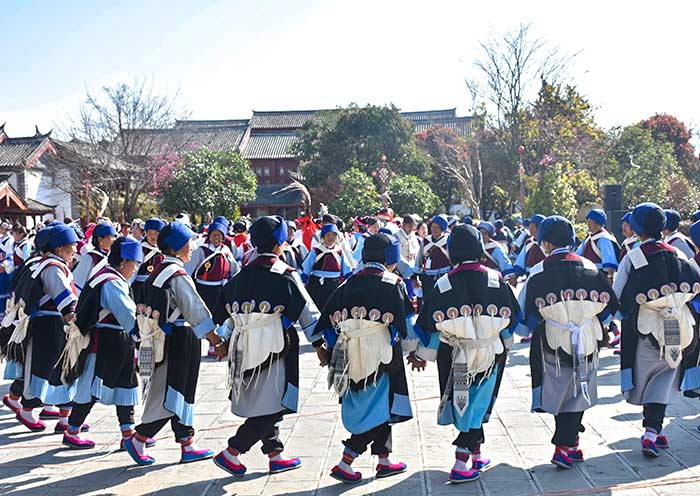
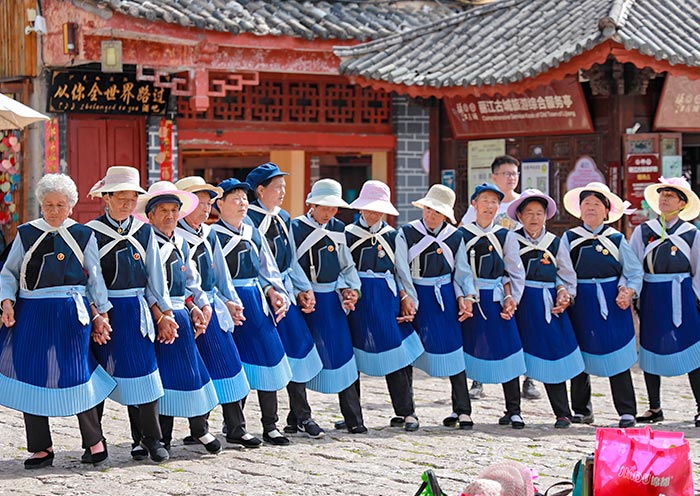
Suggested Walking Routes in Lijiang Old Town
Exploring Lijiang Old Town can take anywhere from half a day to a full day, depending on your pace. Most travelers find the afternoon into evening the perfect time to start—this way, you get to enjoy the town both in daylight and under lantern light. To make sure you don't miss the highlights, here are three classic routes to follow:
1. The Classic Discovery Route
South Gate → Mu Palace → Lion Hill (optional) → Large Water Wheel → Dayan Flower Lane → Wuyi Street → Sifang Street → Xinhua Street → South Gate
- Start at the South Gate, where many boutique guesthouses are located.
- Visit Mu Palace, once home to the Naxi rulers, and if you have time, climb Lion Hill to Wangu Tower for sweeping views.
- After descending, relax with an afternoon tea in one of the charming canal-side cafés.
- Head north to the Large Water Wheel, the town's landmark, before diving into the lively lanes of Dayan Flower Lane, Wuyi Street, and Zhenxing Lane, perfect for street food and dinner.
- End the day in the buzzing nightlife of Sifang Street and Xinhua Street, then stroll back to your hotel through the Old Town's glowing alleys.
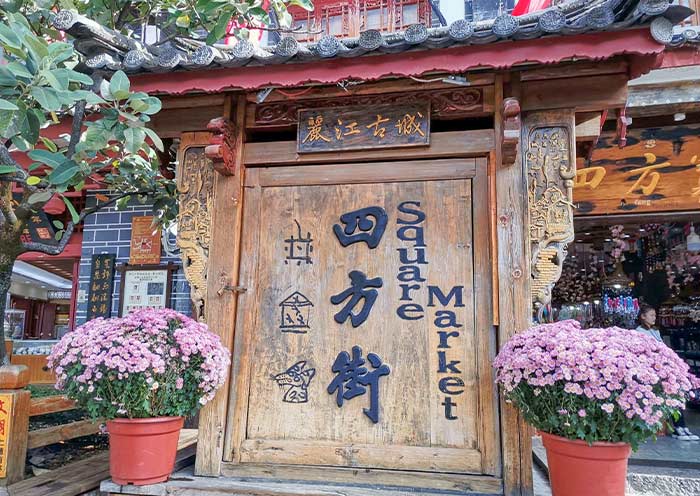
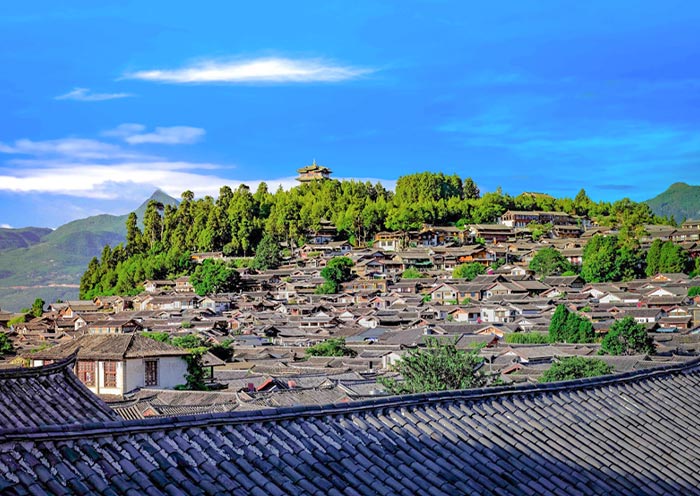
2. The Culture & Nature Route
South Gate → Mu Palace → Wangu Tower (Lion Hill) → Shifang Street → Large Water Wheel → Black Dragon Pool Park → Wufeng Pavilion → Lijiang Museum
- Begin at the Mu Palace for a crash course in Naxi history.
- Climb up to Wangu Tower for the best panoramic view of tiled rooftops backed by Jade Dragon Snow Mountain.
- Walk down Shifang Street, one of the Old Town's quieter, more atmospheric alleys.
- Pause at the Large Water Wheel, then continue to Black Dragon Pool Park, where postcard-perfect views of the Moon-Embracing Pavilion frame the mountains.
- Finish at Wufeng Pavilion and the Lijiang Museum, perfect for travelers who want a deeper dive into history and culture.
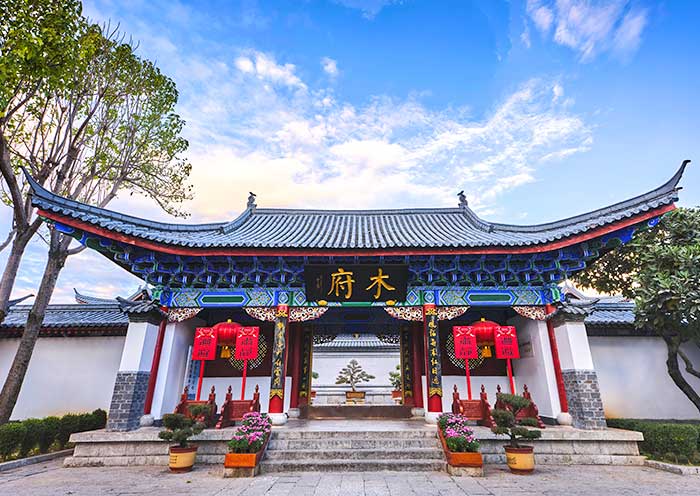
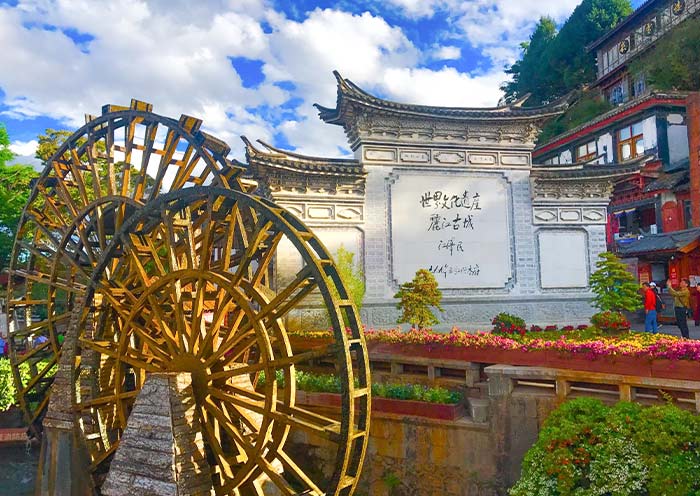
3. The Nightlife & Food Route
Large Water Wheel → Dayan Flower Lane → Wuyi Street → Sifang Street → Xinhua Street → South Gate
- Begin at the Large Water Wheel as twilight falls, when the canals and bridges glow under red lanterns.
- Wander along Dayan Flower Lane, alive with bars, boutique shops, and music.
- Hop through Wuyi Street, Sifang Street, and Xinhua Street, where sizzling street food stalls, yak hotpot, and lively bars compete for your attention.
- Wrap up your evening with a leisurely walk back toward the South Gate, savoring the unique nighttime charm of the Old Town.
With these three routes, you can choose your own focus—history and culture, scenic exploration, or nightlife and food—while still experiencing the essence of Lijiang Old Town.
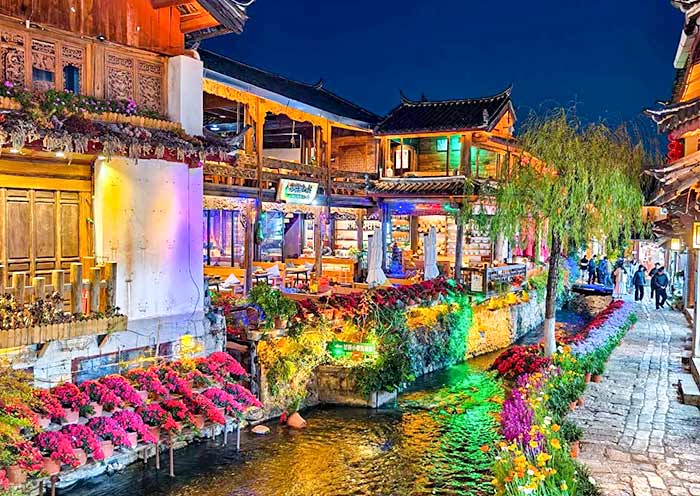
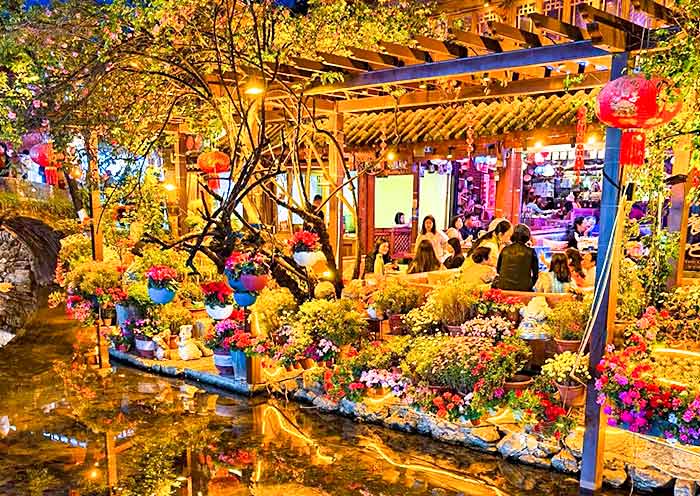
Best Time to Explore Old Town of Lijiang
Best Time of Year – Honestly, Anytime You Like
Lijiang Old Town has a timeless charm that shines in every season—it just depends on what kind of atmosphere you're after.
Spring (March to May): A Blooming Canvas
The cobblestone lanes are framed by blossoms, and the air feels fresh and comfortable. Perfect for strolling or sipping tea by the canals. Just steer clear of the Labor Day holiday (May 1–5), when crowds can be overwhelming.
Summer (June to August): Green & Lively
Mountains are lush, canals brim with flowing water, and evenings buzz with life. Summer rains may occasionally sweep through, but they add to the romance. Nights are especially lively, with music, markets, and lantern-lit alleys.
Autumn (September to November): The Golden Season
Clear skies, crisp air, and golden-red hillsides—it's arguably the best season for both weather and scenery. Just remember, National Day Golden Week (October 1–7) is the single busiest time of year.
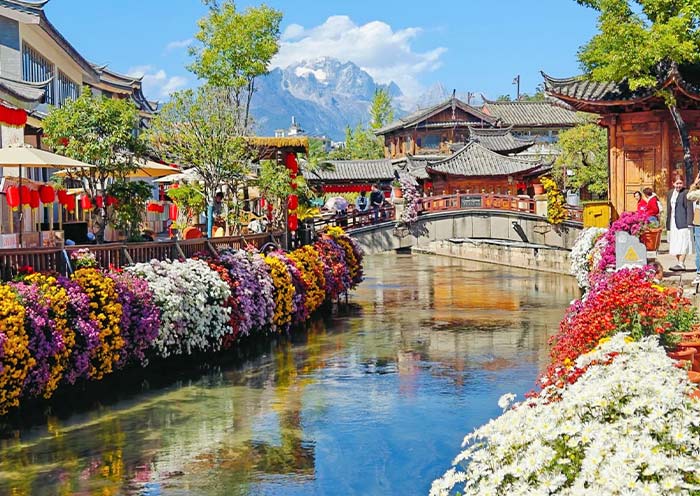

Winter (December to February): Quiet & Festive
Cold, yes, but also peaceful. Snow-dusted mountains make a stunning backdrop, and if you time it with Lunar New Year, the town is alive with color and celebrations. Outside the holiday, it's the quietest, most serene time to visit.
Best Time of Day – Two Moods, Two Charms
Early Morning Serenity (6–9 AM): Almost no tourists, soft golden light, and the sound of water trickling through the canals. This is when the Old Town feels most authentic.
Late Afternoon to Evening: As the sun dips, lanterns glow and music spills into the streets. Nights are for dining, bar-hopping, and wandering under the red lantern light—it's the Old Town at its most magical.
Whether you crave a calm sunrise stroll or the lively energy of nighttime festivities, Lijiang Old Town rewards you with a different kind of beauty at every hour, every season.
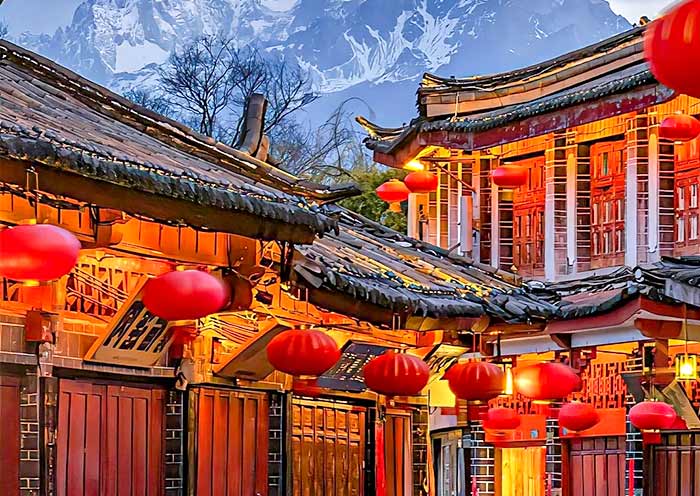
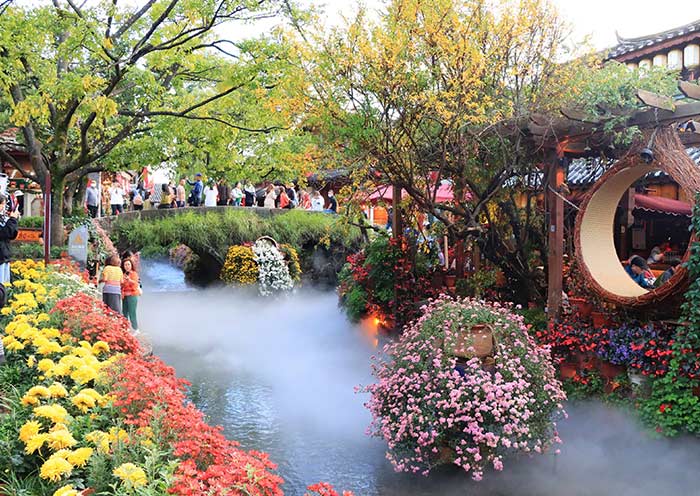
How to Get to Lijiang Old Town
By Air
The easiest gateway is Lijiang Sanyi International Airport (LJG), about 28 km from Dayan Old Town.
It has direct flights from major Chinese cities like Beijing, Shanghai, Chengdu, and Kunming, plus a few international routes (mainly from Southeast Asia).
From the airport, a taxi or Didi gets you to the Old Town in around 40–50 minutes. Airport shuttle buses also run to the city center if you're traveling light.
By High-Speed Train
High-speed rail has made Lijiang far more accessible. The Lijiang Railway Station is connected to Kunming (around 3 hours) and Dali (around 1.5 hours).
From the station, it's just a 15–20 minute taxi ride to the Old Town gates.
By Long-Distance Bus
For budget travelers, buses link Lijiang with Dali, Shangri-La, and Kunming. It's slower and less comfortable than the train, but sometimes the only option for reaching smaller towns in Yunnan.
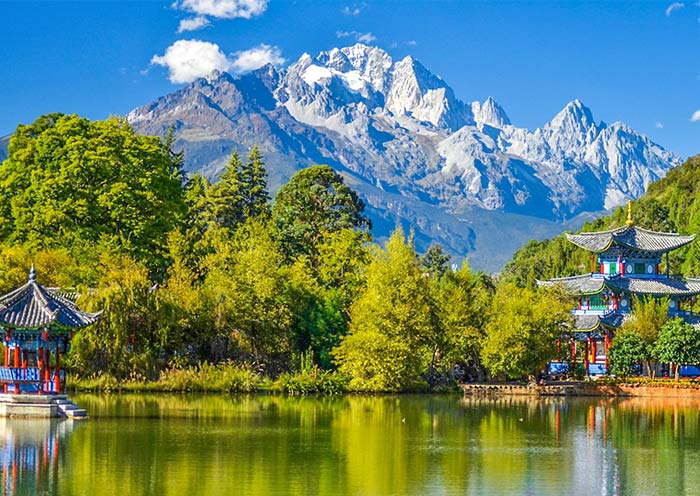
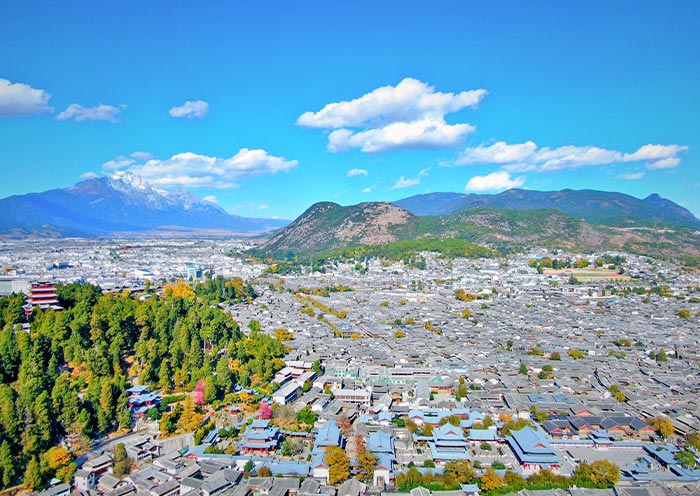
Getting Into the Old Town
Cars can't drive into Dayan Old Town itself—those cobblestone lanes are strictly pedestrian. Most guesthouses will meet you at a nearby gate to help with luggage.
If not, be prepared to roll your suitcase over a few hundred meters of uneven streets (tip: travel light!).
How to Find Authentic Lijiang (and Avoid the Crowds)
Lijiang Old Town is magical—but it's no secret. To experience its true charm, you'll need a few smart moves.
Rule #1: Be an Early Bird
The single best tip for Lijiang: wake up early. Between 6 and 9 AM, the town feels like it belongs to you alone. The cobblestone lanes are quiet, the canals mirror the soft morning light, and you can wander without bumping shoulders with anyone. It's the most enchanting time to feel the heartbeat of the Old Town.
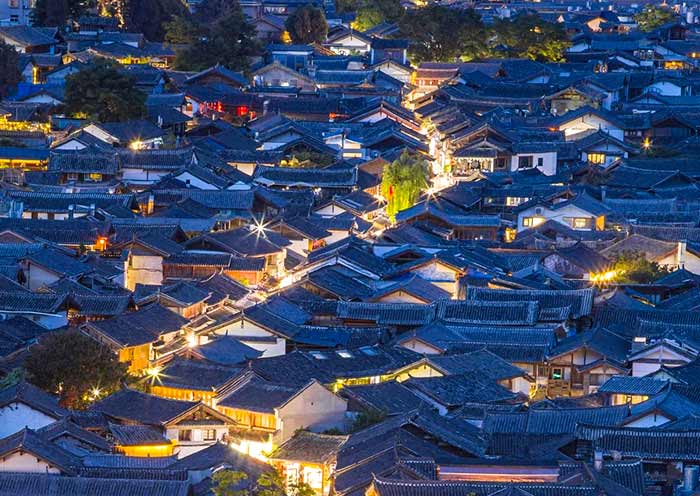
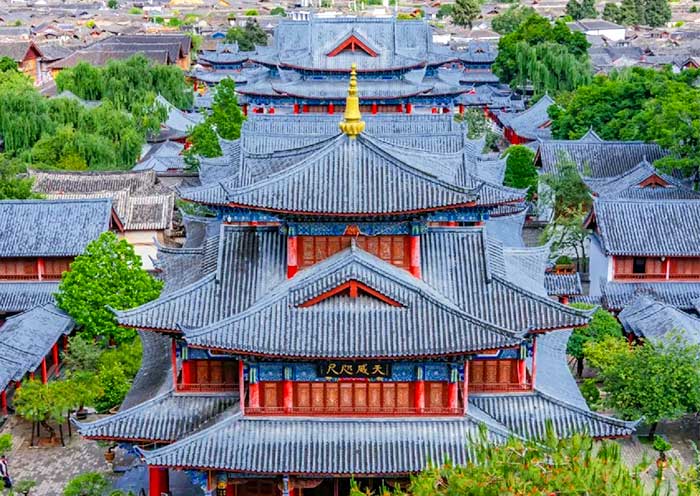
Rule #2: Dive into the Side Alleys
Skip the main drags filled with souvenir shops and bars. The real Lijiang lives in the side alleys, where laundry flutters above you, locals chat in Naxi dialect, and you stumble upon tiny hidden courtyards. Take a turn away from the crowds—you'll be surprised what you find.
Rule #3: Eat Where the Locals Eat
For authentic flavors, don't sit down in the touristy restaurants around the main square. Instead, duck into smaller backstreet eateries where the locals gather. Try hearty dishes like yak hotpot or a warm, chewy piece of Lijiang baba (a Naxi flatbread). That's where you'll taste the Old Town's soul.
Rule #4: Stay in a Traditional Guesthouse
To round out the experience, book a night or two in a Naxi-style courtyard guesthouse. Wooden beams, red lanterns, stone-paved courtyards—it feels worlds away from a modern hotel. You'll wake up to the sound of roosters or trickling water instead of honking horns, making your stay feel more like time travel.
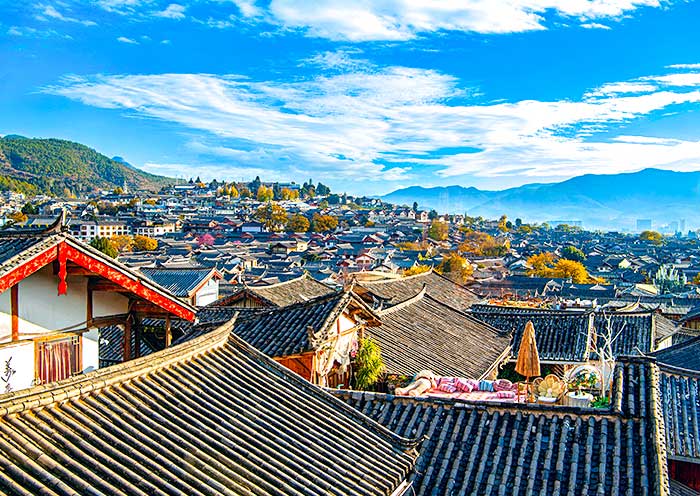
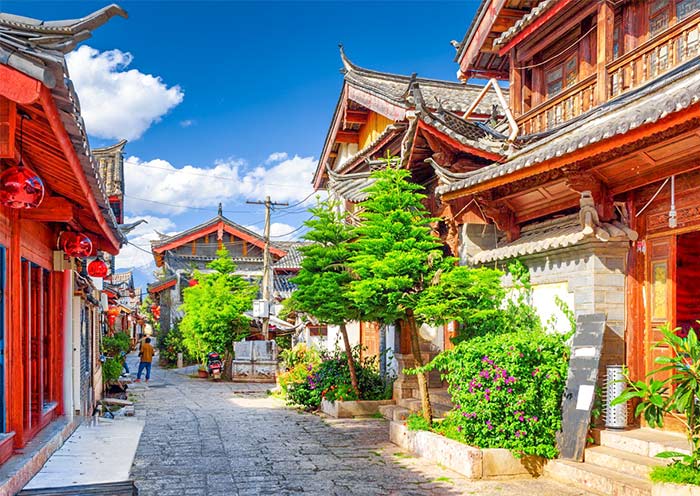
Beyond Dayan: Exploring the Charms of Shuhe and Baisha
Shuhe and Baisha are smaller, quieter, and the perfect antidote to Dayan's energy.
A Half-Day in Shuhe Ancient Town:
If Dayan feels like a festival, Shuhe is more like a gentle melody. Once an important stop on the Ancient Tea Horse Road, it's a smaller, more peaceful version of Dayan. Here, life slows down — you'll find relaxed cafes, boutique inns, and quiet stone-paved streets. It's perfect if you want to experience Lijiang's charm without the tourist bustle.
A Cultural Journey to Baisha Village
Long before Dayan rose to fame, Baisha Village was the cultural cradle of the Naxi Kingdom. With its rustic lanes, local workshops, and the famous Baisha Murals, it feels worlds apart from the polished tourist atmosphere of Dayan. This is the place to meet locals, catch a glimpse of traditional Naxi life, and connect with Lijiang's roots.
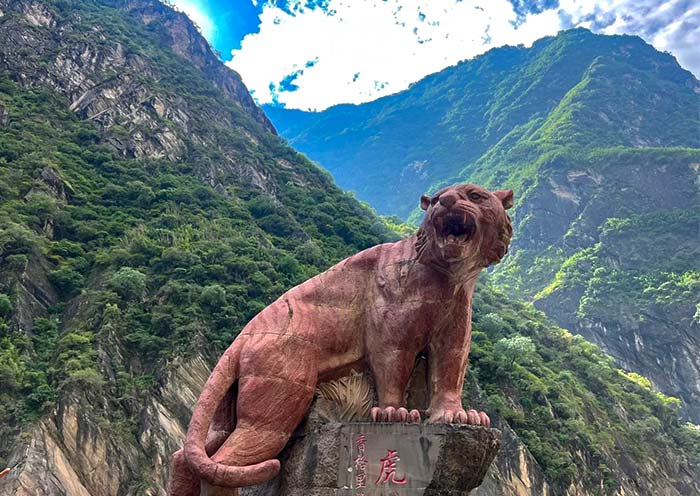
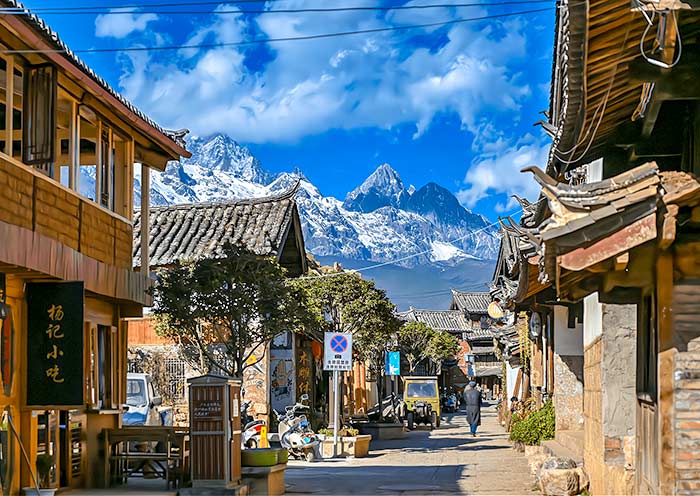
Your Practical Guide to Visiting the Old Towns
Where to Stay (The Big Decision)
Inside Dayan Old Town: If you want to be at the very heart of the action, this is it. Staying here means atmospheric nights under lanterns and easy strolls to Square Street. The downside? Noise, especially if your guesthouse is close to the bar streets, and the hassle of dragging your luggage over uneven cobblestones.
Inside Shuhe Old Town: For travelers who prefer a slower pace, Shuhe is the sweet spot. Its boutique guesthouses are peaceful, with plenty of charm but fewer crowds. The trade-off: a quieter nightlife and fewer dining/shopping choices compared to Dayan.
Outside the Old Towns: If convenience wins for you, modern hotels around the city edge offer car access, elevators, and all the amenities. Just don't expect much Old Town atmosphere once you step outside.
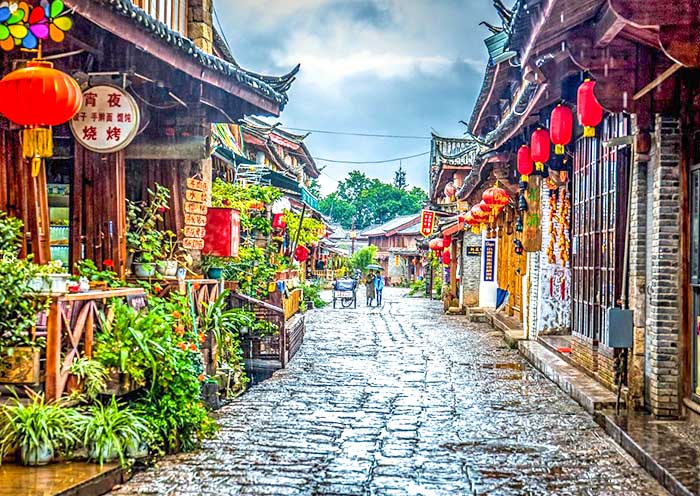
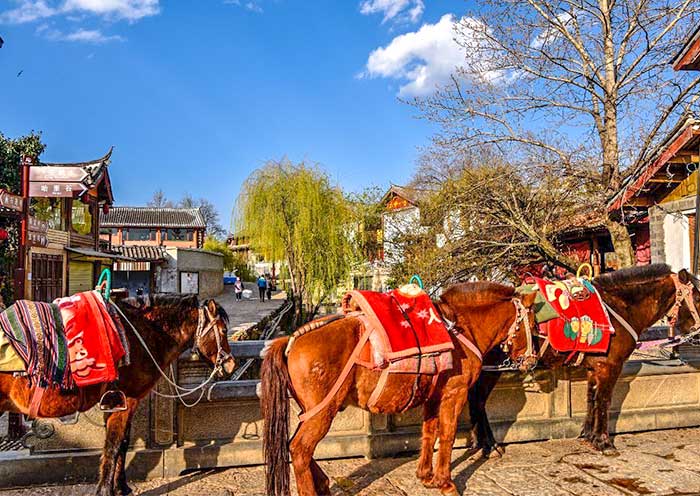
Navigating Between the Towns
Getting around is straightforward: a quick taxi or Didi ride will take you between Dayan, Shuhe, and Baisha in 10–20 minutes. There are also local buses if you're feeling adventurous, but most visitors find cars easiest, especially if time is limited.
The Old Town Maintenance Fee
Here's the thing about the "Old Town Fee": it's a preservation charge (usually around ¥50) that helps maintain the historic sites. You'll often need to show proof of payment when entering places like Mu Palace or Black Dragon Pool.
Some hotels handle it for you; otherwise, it's collected at entry points around Dayan. Don't be surprised—just think of it as your contribution to keeping the cobblestones polished for the next traveler.
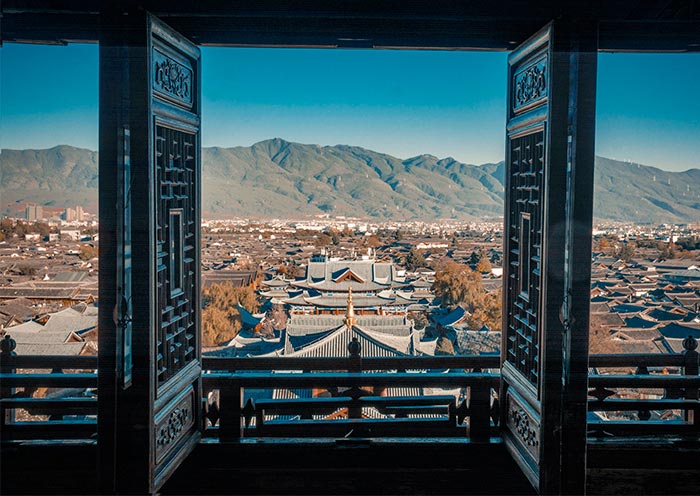
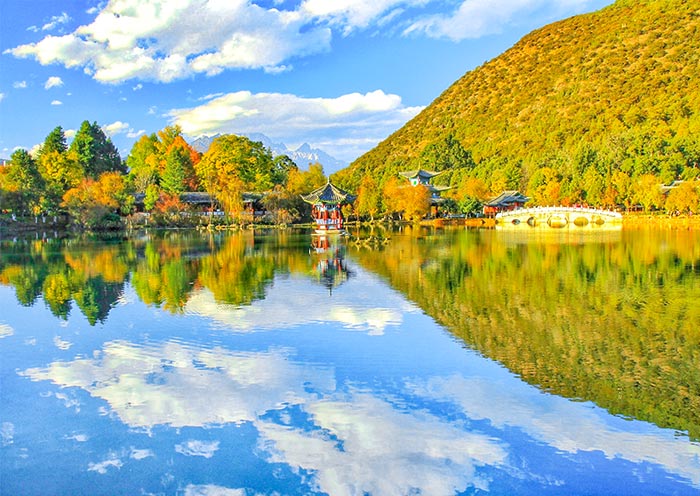
How to Plan a Trip to Lijiang Old Town (Itinerary)
While the Old Town of Lijiang is a prominent attraction, there is much more to explore in the surrounding areas. Spending 2-3 days in Lijiang allows you to immerse yourself in the abundance of nature and culture that the region has to offer. If you have more days, considering a visit to the Shangri-La to meet the Tibetan culture and landscape.On the way to Shangri-La, you'll have the opportunity to changeling the famous hiking trail in Tiger Leaping Gorge.
Day 1: Arrive in Lijiang ans Explore Lijiang Old Town
Spend half a day wandering through the historic streets and experiencing the unique charm of the Old Town.
Day 2: Visit Jade Dragon Snow Mountain
Dedicate a full day to explore the majestic mountain range, enjoying stunning landscapes, taking a cable car ride, and engaging in outdoor activities like hiking or horseback riding.
Day 3: Discover Baisha Village and Shuhe Ancient Town
Spend a day exploring the cultural heritage of Baisha Village, known for its ancient murals, and immerse yourself in the tranquil ambiance of Shuhe Ancient Town with its well-preserved architecture.
Day 4-5: Extend your trip to Shangri-La (Optional)
Venture to Shangri-La to experience Tibetan culture and visit attractions like the Songzanlin Monastery (Little Potala Palace), Napahai, and Pudacuo, which offer natural beauty and serenity.
Day 6-7: Hike Tiger Leaping Gorge (Optional)
Embark on the magnificent hiking trail of Tiger Leaping Gorge, where you can witness the powerful Jinsha River flowing through the narrow gorge.
By following this itinerary, you can make the most of your time in Lijiang, appreciating the blend of nature, culture, and historical sites the region has to offer.

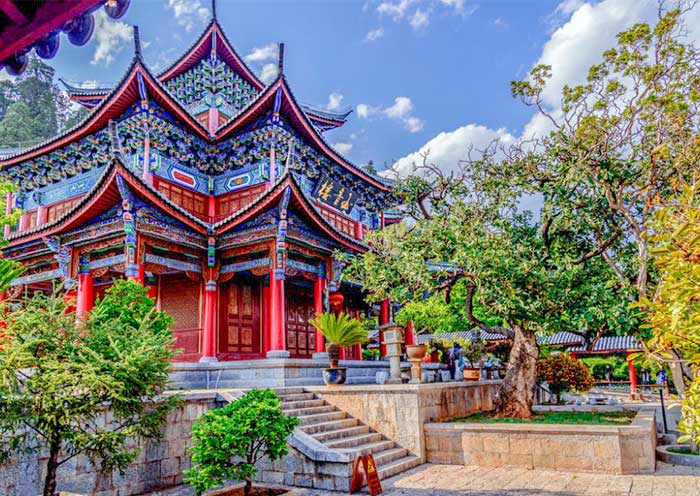
Explore Lijiang Old Town with Asia Odyssey Travel
Wandering the alleys of Lijiang Old Town is magical, but it's easy to get lost in the crowds or miss the authentic corners that make this place truly special. That's where we come in. At Asia Odyssey Travel, we don't just show you the highlights — we help you uncover the hidden courtyards, sip tea in quiet backstreet cafés, and connect with Naxi traditions that most travelers overlook.
Whether you want a half-day stroll through Dayan, a cultural journey into Baisha and Shuhe, or a longer adventure that continues to Jade Dragon Snow Mountain, Tiger Leaping Gorge, or even Shangri-La, we'll craft a trip that feels personal, seamless, and unforgettable.
Let us take the stress out of planning so you can simply wander, discover, and fall in love with Lijiang's timeless charm.
